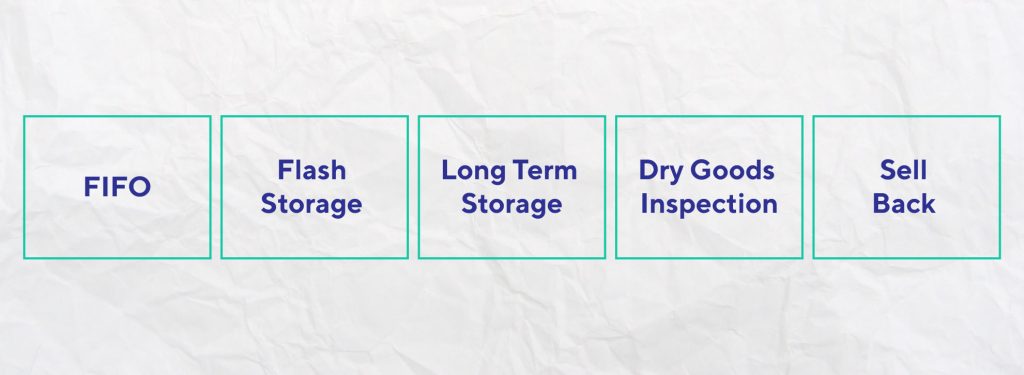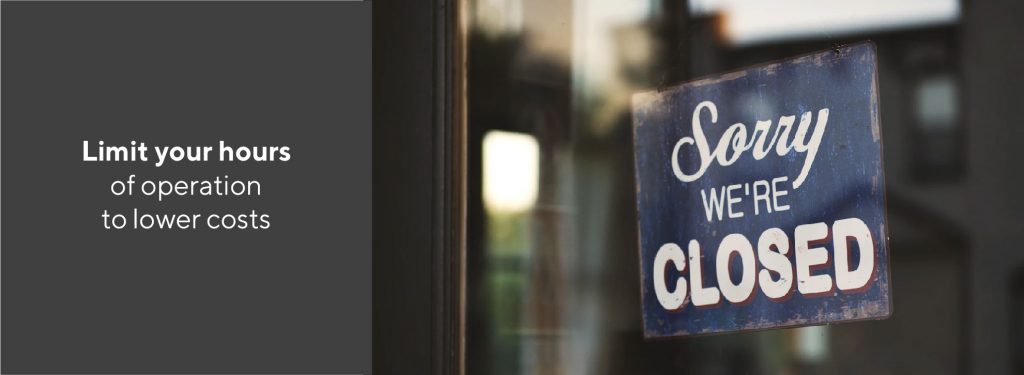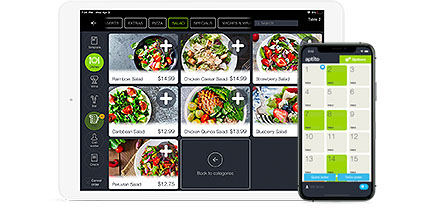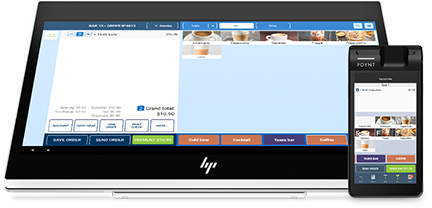
14 Proven Ways to Safeguard Your Restaurant Revenue in Times of Crisis16 min read
The COVID-19 crisis is unprecedented in human history. No other modern event has shut down businesses for this long. The impact of this virus is truly staggering, and restaurants are among the hardest businesses hit. To that end, we dedicate this post to those of you who are struggling to keep costs down in this trying time.
14 Restaurant Revenue Boosters
Follow these steps to bring your costs down. In so doing, you maximize your chances of surviving COVID, and you position yourself to thrive once the threat passes.
#1 Work on Prime Cost
As you know, prime cost is a combination of product costs and labor costs. Product costs are, of course, also known as ‘cost of goods sold,’ or COGS. Proactively managing your prime cost can ensure that your doors stay open—even in tough times. Prime cost is an equation that you can use to manage your profits.
The equation looks like this:

On the product side of things, you include stuff like:
-
Fresh produce
-
Coffee filters
-
Toppings
-
Alcohol
Of course, it’s up to you to know the goods you sell and their collective cost.
People, or labor costs, include:
-
Manager salaries
-
Wages
-
Taxes
-
Benefits
-
…Any other expenses related to managing a team
But don’t include non-inventory costs such as equipment repair, replacement lights or fixtures, or the electric bill.
When you calculate your prime cost, you remove much of the guesswork from your operation. You’re better able to gauge how much money you’re spending on:
-
Inventory
-
Full-time staff
-
Part-time staff
-
…Other controllable expenses
Think of your prime cost like a rudder for your business. If you’re captaining a ship with no rudder, well, you won’t get far. Let’s say that you know your costs are too high. But you don’t know which aspect of your business is causing the leak. Working with the above formula will give you that insight.
You can take this a step further, too. If you divide your product and labor costs by your total sales, you arrive at the prime cost ratio. It looks like this:
(Total Labor Cost + Cost Of Goods Sold)/Total Sales = Prime Cost Ratio
You can calculate this ratio for any length of time you want, including:
-
Daily
-
Weekly
-
Monthly
-
Yearly
Calculating your prime cost ratio on a regular, or rolling, basis gives you powerful insights into your money flow. In general, the shorter the period you calculate, the better equipped you’ll be to survive stressful times, such as the COVID pandemic. In other words, knowing your prime cost ratio gives you the agility you need to survive tough times.
Note that if you only check your prime cost ratio once per quarter, you’ll be missing out on important information. Calculating it per quarter is useful, no doubt. But you should also look at your weekly numbers. Particularly during a stressful situation like COVID.
#2 Get a Handle on Labor Costs
Next, make sure you’re doing everything you can to bring labor costs down. As you’re no doubt aware, labor is one of the biggest costs in pretty much any restaurant. Of course, with layoffs due to the COVID-19 situation, discussing labor costs can be a bit of a sticky topic. We get it. But the fact remains, if you don’t closely track your labor costs at all times, it can quickly eat into your margins.
As you’ve seen, managing labor properly is essential if you want to keep your prime cost reasonable. These days, your best bet is to use scheduling and attendance assistance solutions to help you manage your team. These software applications give you a top-down view of your labor costs. Without them, you won’t know how much you’re spending on labor at any one time. Worse, you’ll never know if you can really afford to call in that extra server.
Over time, such sloppy tracking can eat into your profits.
Attendance systems, in particular, can be very helpful. They track employee clock in/clock out, spotting problematic behaviors. For instance, if you have an employee who habitually clocks in early, this sort of software will notice that.
These programs help you analyze employee data visually, which can help you spot unusual behavior. For instance, you may have:
-
One employee clocking in for another, even though that employee is not yet physically on the premises
-
Employees clocking in and then going to the break room for 15 minutes before starting work
-
Managers covering for their friends
All of these behaviors bloat your labor costs over time. It’s imperative that you demand respect from your team; they are not to abuse the clock. Make it clear that in times like these, their jobs depend on them helping you keep labor costs reasonable. To spot these aberrant behaviors, you may need to pair your attendance software with your surveillance camera footage. Some software solutions may automatically integrate with your surveillance system.
At the same time, invest in your staff. Have a think about how you can better train them. It’s a fact that well trained staff will stick around longer. Lower turnover ultimately means lower labor cost.
#3 Partner with Other Businesses
Businesses everywhere are hurting. It’s in your best interest to partner where you can. However, you want to do so strategically and sensibly. Here are a few examples to get your mental gears rolling:
-
A coffee roaster that teams up with a local brewery to offer a coffee porter
-
A restaurant that closes at noon only to allow another business to open up shop on the premises in the evenings
-
A restaurant that partners with a bottling company or store to sell its signature sauce or dressing
-
A restaurant that lets other restaurants or food carts ‘rent’ their drive-thru window
You can really get creative here. Just don’t rush into anything. Once you start looking, you’ll find plenty of opportunities to partner up. So don’t work with anyone who gives you a bad feeling.
#4 Make the Most of Your Inventory
Getting every bit of value out of your inventory is more important now than ever. As you navigate the COVID-19 crisis, think of ways you can cut costs by extending inventory. For instance, if you can safely salvage vegetable scraps that you would otherwise throw away, do so. Vegetables can add bulk to dishes such as:
-
Stews
-
Soups
-
Cocktails
-
Baked goods

Note that vegetables add valuable fiber to baked goods in particular. Adding more fiber to your dishes can make them more filling. This in turn can contribute to a perception of value for money that can boost sales. Fruits can add bulk to parfaits and salads.
You can even set up a special prep table for vegetables and fruits nearing expiration. As you might expect, the employee at this table is responsible for prepping these vegetables for use in the dishes above.
#5 Buy Seasonally
Did you know that buying produce seasonally is generally cheaper? When a fruit or vegetable is in season, supply increases. This usually results in lower cost. When you start working on your COVID-centric menu, keep this in mind. Work with your suppliers to create dishes that utilize in-season produce.
#6 Tweak Your Menu
Check your point-of-sale system frequently. Look at sales data for all of your dishes. Which dishes have fallen off a cliff since COVID hit? Do those dishes require special ingredients? If you need to, remove them from your menu for now and save on the inventory cost. Streamlining your menu can also reduce stress on your chef and kitchen staff, which will generally make them more efficient.
If a beloved menu item has stopped selling, and you can’t bring yourself to part with it, offer it as a weekly special instead.

#7 Use Multiple Vendors
During these uncertain times, you may need to open negotiations with multiple vendors. Shopping for the best price takes time, and time is money. We get it. But you need to keep tabs on the going rates for the goods you’re buying. It’s possible that you’re paying more than you need to. Do you have a long-standing relationship with a single vendor? When was the last time you looked at prices?
Your relationship with your vendor is important. But they should understand the implications of the current situation. If they get pushy or defensive when you question them on prices, it may be time to move on.
#8 Operating Costs Revisited
While knowing your prime cost is pivotal, you must also keep tabs on your profit and loss statement. Your P&L is the pulse of your business, and you should check that pulse often. In short, you need to know where every dollar is coming from and where it’s going to.
P&L may also be known as:
-
Income statement
-
Statement of operations
-
Statement of earnings
It’s a big picture look at your overall operation. The P&L reveals your strengths and weaknesses by reflecting costs subtracted from sales. Any decent point-of-sale system can give you intel into your P&L situation. For instance, you can gain insights into:
-
Dishes that are not selling
-
Which dishes are best sellers?
-
Revenue day to day, over a period of time, and averaged
If you retain an accountant to handle your finances, ask them to show you the latest P&L statement. Then ask them to compare the P&L to your minimum operating costs. If your costs are rising and your profits are shrinking, you’re in trouble. Keep returning to this post—and this blog—to implement cost-reducing measures until the situation reverses.
#9 Approach the Bank
If you know you’re in danger of defaulting on business loans, you need to approach the bank sooner rather than later. This includes:
-
Loans you took out to fund your business
-
PPP Loans
-
Financed equipment
Because of the unique nature of the COVID-19 situation, many banks are offering relief. This doesn’t mean that a pre-existing loan will be forgiven or that you won’t have to repay. But you may be able to negotiate more time to pay. In general, this relief takes the form of:
-
Deferment of interest and principal payments for two to six months
-
Existing lines of credit are maintained
-
Depending on your credit, your credit limits may be increased
Note, however, that not all banks offer this aid. Whether you qualify may also depend on several factors, such as your pre-COVID P&L statement or prime cost. Many banks are also offering special loans. These new loans have fewer restrictions and may have forgiveness baked in. However, you must read the fine print, and you should only deal with a reputable bank. Remember: whenever there is a crisis, there will be bad actors trying to take advantage.
Additionally, many countries are rolling out their own loan programs in response to the crisis. For instance, Canada offers the Business Credit Availability Program. This program provides $65-billion in direct lending to Canadian businesses. Of course, the U.S. has the CARES ACT, which authorizes the Small Business Administration to offer small business loans to help restaurant owners meet payroll.
#10 The Menu—Revisited
Above, we touched briefly on the importance of a COVID-centric menu. But the tip you’ll learn in this section can help you through any crisis. Go ahead and run your POS reports so you can get an idea of how each of your dishes is selling. We’ll wait.
Now, here’s the key: if your POS software doesn’t rank and label your dishes automatically, you need to do that on your own. There are four dish categories, and you must know which category each dish falls into. The categories are:
Best Sellers.
These dishes are both very popular and are also very profitable.
Staples.
These dishes are popular but are not very profitable
Darlings.
These dishes are very profitable but not very popular
Dead weight.
These dishes are neither profitable nor popular

Clearly, best sellers are essential to the wellbeing of your restaurant. Your best sellers keep you top of mind with customers. These dishes are why they keep coming back. Now is not the time to change these dishes. Don’t drop ingredient quality in an effort to save on costs. Don’t change your recipes. Instead, look at the other three categories.
Staple dishes don’t bring a lot of cash per sale, but they sell reliably.
Darlings are fine in times of plenty, but you must consider cutting them from your menu when times get tough. You may be able to move more units of a darling dish by putting it on sale.
Dead weight dishes are a luxury you can ill afford right now. Cut them. Don’t offer them just to pad your menu. They’re costing you money. Beware any dead weight dish that requires special ingredients. If you have an ingredient that is only used in dead weight dishes, cut those dishes and stop ordering that ingredient. At least for now.
By removing a few darling and dead weight dishes, you alleviate stress on your kitchen. This increases efficiency by reducing prep times. Your best sellers and staples will get the star treatment they deserve, and this will increase customer satisfaction. A smaller menu will also help your customers decide on what they want faster. This can increase overall efficiency.
In a similar vein, think about whether your dishes are easy to prepare. Rotisserie chicken is more complex and time consuming to prep than, say, a sandwich. If you have darlings that take a long time to prepare, you may be better off replacing them with a new dish that has staple potential.
Finally, paring your menu down will make your operation trimmer and more agile. This automatically orients you toward takeout and delivery, which is where the money is right now. Fewer, simpler dishes will help you get orders out the door quickly, and that will keep customers coming back.
#11 Inventory Revisited
Up to 10 percent of perishable food purchased by restaurants ends up in the trash. Even inventory management methodologies like FIFO can’t make a big dent. Therefore, it’s imperative that you do all you can to reduce inventory waste. Fortunately, there are several steps you can take right now to do just that.
Revisit FIFO
Are your employees respecting your FIFO policy? Audit your storage areas yourself to make sure. And don’t forget pre-made items like parfaits. Do they have stickers indicating when they need to be thrown out? Can employees easily tell new from old?
Hold Flash Sales
Have you ever seen ‘suspiciously cheap’ meat in the supermarket? What’s happening there? The meat is about to hit its expiration date, and rather than lose out completely, the store sells it at a loss. This way, they can at least recoup some of their investment. You can do the same thing. If you have items that are spoiling soon, check to see which dishes use them. Hold flash sales on those dishes to move that inventory before it becomes waste.
Store Items Long Term
Do you have any items in the fridge that could actually be in the freezer? If you won’t need them for a while, consider moving them. They’ll probably last longer.
Check Dry Goods for Signs of Infestation
Check your dry goods storage area for signs of rat droppings and insect debris. This is more of a preventative measure. If roaches or mice are going to make a home out of your restaurant, you need to know as soon as possible. Rat urine and feces can cause severe illness in humans. Any cans or other items sporting rat droppings need to be tossed.
Look for Items You Can Sell Back
Do you have a large supply of beer that you can’t sell because of low foot traffic? See if you can sell it back to the vendor or to another business. If you’ve purchased bulk goods within the last few months, it doesn’t hurt to ask if you can return those items for some money back.
Can You Repurpose Anything?
Do you have raw ingredients like herbs? If you’re seeing lower foot traffic than normal, it’s likely that those herbs will go bad. But the good thing about herbs is that you can mix them with other products. For instance, you could use the herbs to add zest and a hint of freshness to dressing. Don’t let these items go bad—use them.
#12 Get Into the Online Ordering Game
Even if COVID-19 hadn’t hit, we’d still be moving toward online ordering and takeout. It would have taken longer to go mainstream, but it would have happened. Online ordering is the future. There are two ways to go about it:
-
Set up online ordering on your own site
-
Use a third-party service
In general, online ordering on your own site is the better option since it gives you the most control. But if you need a quick solution, Uber Eats and GrubHub can be good options. They take a cut of every sale made via their system, though. You also have to work with their contracted drivers, which can be a pain sometimes. One benefit of creating your own system is that your drivers are usually in-house staff. This tends to result in smoother operation.
Note that most of these third-party providers charge a one-time fee to get started. This fee usually amounts to hundreds of dollars, at least.
If you do use a third-party solution, check with them to see if they’re offering restaurant relief right now. For instance, Uber Eats waved delivery fees for 100,000 restaurants across the U.S. The following providers may also have relief programs:
-
Ritual
-
DoorDash
-
Postmates
-
GrubHub
In addition, check with your software vendors. Some of them may work with other companies, and they, together, may be offering support for restaurants. After all, they only survive if restaurants survive.
#13 Cut Your Hours
It’s not optimal to have to cut your hours, we know. But slashing your hours will drop your electric and water bills. Cutting your hours will also lower your labor costs. Check your POS’ historical data to find your busiest times of day. If you don’t do much breakfast business and never have, ask yourself whether you need to offer breakfast right now.
#14 Work with a Smaller Staff

We get it. You don’t want to let anyone go. But if it comes down to it, what choice do you have? If the entire operation fails, they’ll lose their job anyway. Desperate times call for—well, you know. Look at your staff as objectively as you can. Determine who is essential. Anyone who is non-essential may need to be laid off, at least temporarily.
You’ll still need back-of-house staff, but you probably don’t need as many as you’re keeping on right now. You can almost surely trim the front-of-house staff too. Note that dropping down to a skeleton crew will probably mean you have to do some of the grunt work. Desperate times, and all that.
We hope this post has proved helpful for you in these difficult times. If it has, can you give us a share? We’d definitely appreciate it!



